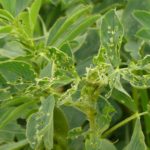This article was originally published in 2021 in the Milk Producer Magazine produced by Dairy Farmers of Ontario. Written by Michelle Linington Providing proper care and nutrition to transition cows ensures a problem-free lactation and herd. The transition period occurs between late gestation and the onset of lactation. This is the time when there is [...]
Alfalfa Weevil

This article was originally written by Joel Bagg in 2013. It was edited May 25th, 2022 by Christine O'Reilly to reflect current insecticide options to control alfalfa weevil. Alfalfa weevil can be an issue in Ontario, particularly in south-western parts of the province. While outbreaks tend to be isolated, they can be severe and dramatically [...]
Applying the Principles of Marginal Gains Theory to Beef Production Systems
Using marginal gains theory to make improvements in beef production systems…Marginal gains theory has been used across many different sectors and facets of life to make impactful improvements, hit targets, and ultimately to achieve success. In this interesting take, OMAFRA Beef Cattle Specialist James Byrne describes how the principles of marginal gains theory can be applied to beef production systems to drive improvement of production and economic performance.
Improving herd genetics in beef cattle: The promising role of Python computer programming language in genetic evaluation systems
A promising new technology to develop genetic evaluation systems…When it comes to genetic evaluation systems, the technologies backing these systems have a big impact on outputs generated for genetic improvement at the herd and sector levels. Researchers from the University of Guelph and University of São Paulo in Brazil, in collaboration with AgSights, have tested out a new computer programming language called Python that holds great potential to improve the development of genetic evaluation systems. This article provides a line of sight into how new technologies used to develop genetic evaluation systems are assessed and how they can be utilized to support genetic improvement in the beef sector.
Beef up your forage intake rates on pasture
Considering bunchgrass management as a pasture management strategy…As we draw closer to spring turn-out, it’s a good time to think about strategies to improve grazing and pasture management for optimized cattle performance. Using recent research investigating factors that influence dry matter intake, OMAFRA Forage and Grazing Specialist Christine O’Reilly explains why the amount the of forage and types of plant structures (notably bunchgrasses) are important factors to consider when managing pastures. Read on to learn more about how bunchgrasses can be managed to optimize intakes on pasture.
Managing seeding rate to reduce the risk of sorghum species affecting other crops
This article was originally published in 2021 in the Milk Producer Magazine produced by Dairy Farmers of Ontario. Written by Christine O’Reilly Sorghum species—including forage sorghum, sudangrass and especially their hybrid sorghum-sudangrass—are gaining popularity in Ontario as forage crops. To increase palatability and digestibility in sorghum species, many producers have been increasing the seeding rates [...]
IMPROVING COLOSTRUM ABSORPTION IN CALVES
By Marlene Paibomesai Colostrum is important for passive immunity, neonate nutritional needs and calf development. Colostrum is a source of immune factors, fatty acids and protein that the calf needs early in life. Colostrum components are absorbed by the small intestine to effectively protect and provide nutrition to the neonate calf. Circulating IgG and other [...]
Tiny world, Big Impact
A calf's microbiome is established very early in life. The microscopic world cannot be seen, but it can impact dairy production, health, and the environment. We tend to think of microbes in the context of causing disease, but they are a key driver of life and provide many benefits to animals, especially to the ruminant. [...]
Nurturing the New Cattle on the Block: Setting cattle up for success when they arrive at the feedlot
Nurturing new arrivals to the feedlot… Have you reviewed your receiving program lately? The spring cattle run is upon us, marking a great time to review and reflect upon practices that set cattle up for success in the feedlot from the start. This article by OMAFRA Beef Cattle Specialist, Megan Van Schaik, highlights some key practices to consider as part of a receiving program that can help achieve a smooth transition for new arrivals.
Does Yeast Supplementation in High-Grain Feedlot Diets Help with Recovery from Induced Ruminal Acidosis Challenge?
Beyond baking bread: exploring the role of yeast in feedlot rations… Yeast has long been explored as an additive to livestock rations to enhance gut health. Through her research at the University of Guelph, Dr. Melissa Williams has investigated how yeast plays a role in feedlot rations, most recently exploring the impact of yeast supplementation to beef cattle fed high-grain diets with monensin and how yeast affects gut wall permeability. Read on for more details on the study design and findings.
